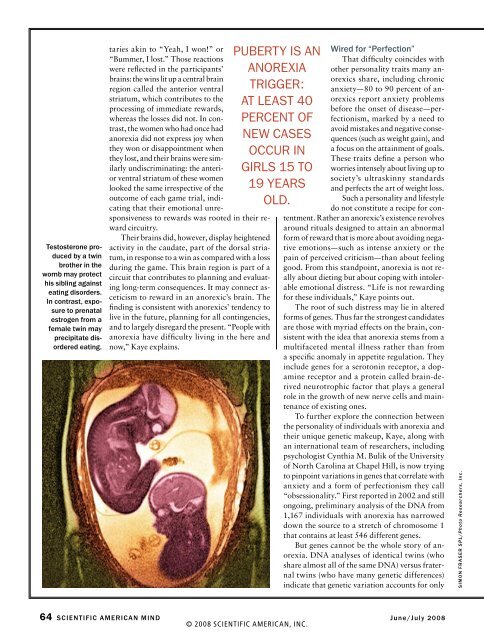Addicted to Starvation - Trisha Gura
Addicted to Starvation - Trisha Gura
Addicted to Starvation - Trisha Gura
Create successful ePaper yourself
Turn your PDF publications into a flip-book with our unique Google optimized e-Paper software.
tes<strong>to</strong>sterone produced<br />
by a twin<br />
brother in the<br />
womb may protect<br />
his sibling against<br />
eating disorders.<br />
in contrast, exposure<br />
<strong>to</strong> prenatal<br />
estrogen from a<br />
female twin may<br />
precipitate disordered<br />
eating.<br />
taries akin <strong>to</strong> “Yeah, I won!” or<br />
“Bummer, I lost.” Those reactions<br />
were reflected in the participants’<br />
brains: the wins lit up a central brain<br />
region called the anterior ventral<br />
striatum, which contributes <strong>to</strong> the<br />
processing of immediate rewards,<br />
whereas the losses did not. In contrast,<br />
the women who had once had<br />
anorexia did not express joy when<br />
they won or disappointment when<br />
they lost, and their brains were similarly<br />
undiscriminating: the anterior<br />
ventral striatum of these women<br />
looked the same irrespective of the<br />
outcome of each game trial, indicating<br />
that their emotional unresponsiveness<br />
<strong>to</strong> rewards was rooted in their reward<br />
circuitry.<br />
Their brains did, however, display heightened<br />
activity in the caudate, part of the dorsal striatum,<br />
in response <strong>to</strong> a win as compared with a loss<br />
during the game. This brain region is part of a<br />
circuit that contributes <strong>to</strong> planning and evaluating<br />
long-term consequences. It may connect asceticism<br />
<strong>to</strong> reward in an anorexic’s brain. The<br />
finding is consistent with anorexics’ tendency <strong>to</strong><br />
live in the future, planning for all contingencies,<br />
and <strong>to</strong> largely disregard the present. “People with<br />
anorexia have difficulty living in the here and<br />
now,” Kaye explains.<br />
puberty is An<br />
AnorexiA<br />
trigger:<br />
At leAst 40<br />
percent of<br />
new cAses<br />
occur in<br />
girls 15 <strong>to</strong><br />
19 yeArs<br />
old.<br />
wired for “Perfection”<br />
That difficulty coincides with<br />
other personality traits many anorexics<br />
share, including chronic<br />
anxiety—80 <strong>to</strong> 90 percent of anorexics<br />
report anxiety problems<br />
before the onset of disease—perfectionism,<br />
marked by a need <strong>to</strong><br />
avoid mistakes and negative consequences<br />
(such as weight gain), and<br />
a focus on the attainment of goals.<br />
These traits define a person who<br />
worries intensely about living up <strong>to</strong><br />
society’s ultraskinny standards<br />
and perfects the art of weight loss.<br />
Such a personality and lifestyle<br />
do not constitute a recipe for contentment.<br />
Rather an anorexic’s existence revolves<br />
around rituals designed <strong>to</strong> attain an abnormal<br />
form of reward that is more about avoiding negative<br />
emotions—such as intense anxiety or the<br />
pain of perceived criticism—than about feeling<br />
good. From this standpoint, anorexia is not really<br />
about dieting but about coping with in<strong>to</strong>lerable<br />
emotional distress. “Life is not rewarding<br />
for these individuals,” Kaye points out.<br />
The root of such distress may lie in altered<br />
forms of genes. Thus far the strongest candidates<br />
are those with myriad effects on the brain, consistent<br />
with the idea that anorexia stems from a<br />
multifaceted mental illness rather than from<br />
a specific anomaly in appetite regulation. They<br />
include genes for a sero<strong>to</strong>nin recep<strong>to</strong>r, a dopamine<br />
recep<strong>to</strong>r and a protein called brain-derived<br />
neurotrophic fac<strong>to</strong>r that plays a general<br />
role in the growth of new nerve cells and maintenance<br />
of existing ones.<br />
To further explore the connection between<br />
the personality of individuals with anorexia and<br />
their unique genetic makeup, Kaye, along with<br />
an international team of researchers, including<br />
psychologist Cynthia M. Bulik of the University<br />
of North Carolina at Chapel Hill, is now trying<br />
<strong>to</strong> pinpoint variations in genes that correlate with<br />
anxiety and a form of perfectionism they call<br />
“obsessionality.” First reported in 2002 and still<br />
ongoing, preliminary analysis of the DNA from<br />
1,167 individuals with anorexia has narrowed<br />
down the source <strong>to</strong> a stretch of chromosome 1<br />
that contains at least 546 different genes.<br />
But genes cannot be the whole s<strong>to</strong>ry of anorexia.<br />
DNA analyses of identical twins (who<br />
share almost all of the same DNA) versus fraternal<br />
twins (who have many genetic differences)<br />
indicate that genetic variation accounts for only<br />
64 scientific american mind June/July 2008<br />
© 2008 SCIENTIFIC AMERICAN, INC.<br />
simon fraser SPL/Pho<strong>to</strong> Researchers, Inc.



